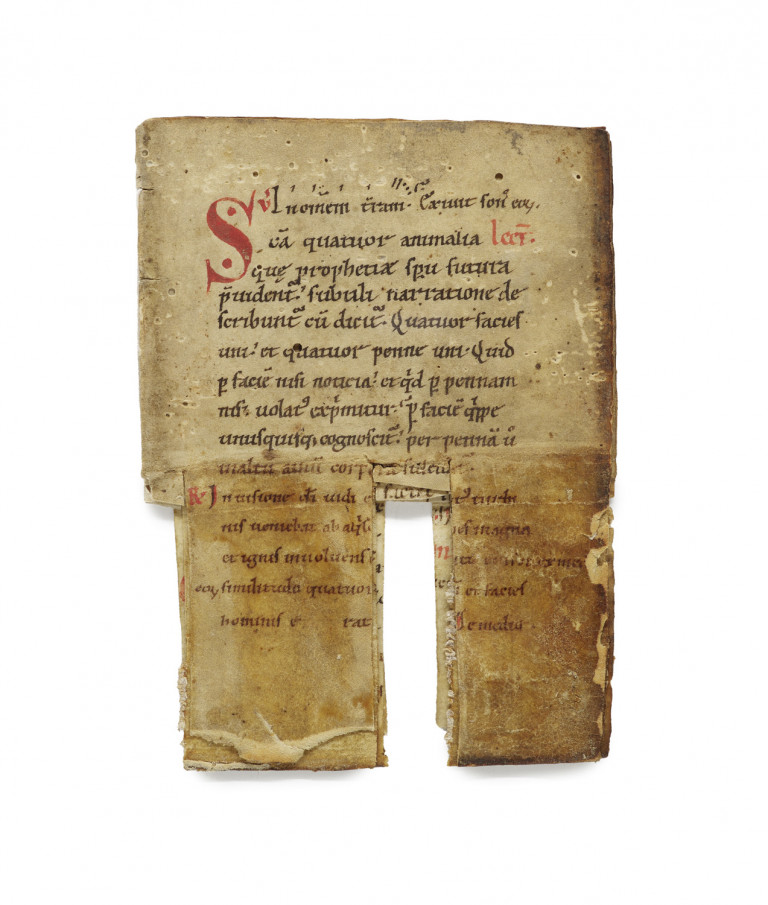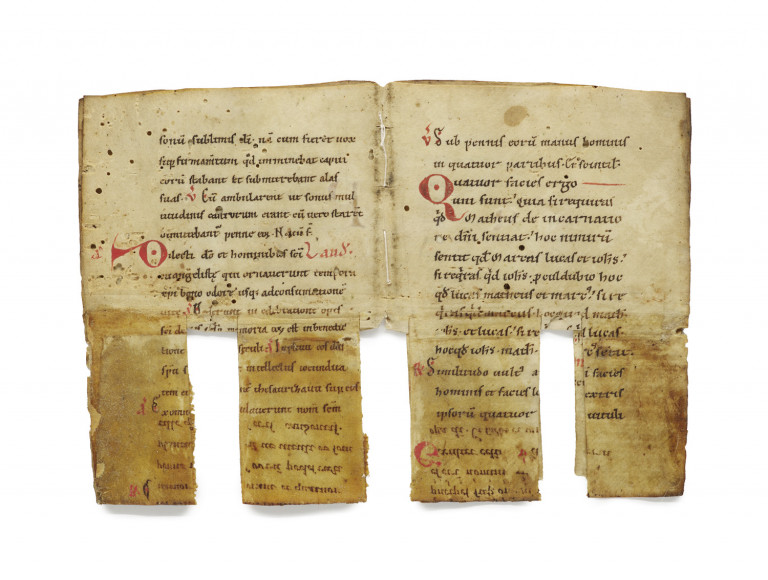Online Catalogue with all Lots / Auction 157
Rare Books, Prints, Historical Photography
Friday, 24 October 2025 at 11:00 am Lose 1- 1105
Saturday, 25 October 2025 at 11:00 am Lose 1106-2003 - After sale
Lot 194 Fragment von 4 Bll. mit 13 …
Fragment von 4 Bll. mit 13 roten Lombarden und Rubrizierungen einer frühgotischen Handschrift. 15 Zeilen. Aus: Hrabanus Maurus, "De Universo/De rerum naturis". Textualis auf Pergament. Frühgotische Minuskel als Hauptschrift mit Rubrizierungen. Schriftraum 8,5 x 6,7 cm Format: 12,3 x 8,9 cm. Mit Heftung. Böhmen, Süddeutschland oder Österreich, Wende 12./13. Jahrhundert.
Mittelalter
Manuskripte und Urkunden – Patrologia Latina, Bd. 111, Sp. 440 (Text). - Proveninenz: Nachlass eines Buchbinders, Rheinland Pfalz. - Makulaturfragment aus einem Einband. Zur GRAPHOLOGIE Die Schrift ist stark vertikal betont, Bögen und Schäfte brechen oft spitz ab, viele enge Bogenverbindungen (insbesondere bei "m", "n", "u"), das "a" ist zweistöckig und das "g" hat einen geschlossenen Unterbogen, während der obere Teil offen bleibt. Die Initiale "S" ist reich verziert und rot ausgerollt, wodurch sie aus dem Text hervorgehoben wird, häufiges Merkmal in liturgischen und exegetischen Werken des Hochmittelalters. PALÄOGRAPHISCH zeigt sich ein klarer Übergang von der karolingischen Minuskel zur gotischen Buchschrift: Die Buchstaben sind gedrängt, die Mittellängen kurz gehalten und Ober- wie Unterlängen wenig ausgeprägt, kennzeichnend für Textualis Buchschrift nördlich der Alpen um 1200-1250. Die Rubrizierung ("lect." in Rot) weist zudem auf eine liturgische Nutzung hin und ist typisch für Handschriften aus kirchlichen Skriptorien dieser Zeit. Die frühgotische Buchschrift, die auf dem Fragment zu sehen ist, weist charakteristische Elemente der Textualis aus dem späten 12. bis mittleren 13. Jahrhundert auf, wie sie besonders häufig im deutschsprachigen Raum südlich der Donau und in Österreich, Böhmen sowie Teilen Süddeutschlands (Regensburg, Nürnberg, Salzburg, Klosterneuburg) verbreitet war. Merkmale wie zweistöckiges "a", spitze Brechungen, dicht gedrängtes Schriftbild, sowie die Auszeichnung durch rote Initialen und Rubriken sind dabei typisch für diese Region. INHALTLICH beginnt das Fragment mit der Phrase "Sancta quatuor animalia, quae prophetiae spiritu futura praevidentur subtili narratione describuntur, cum dicitur..." Die genaue Stelle stammt aus Hrabanus Maurus, "De rerum naturis" (auch "De universo" genannt), Buch 12, Kapitel 6, wo er die vier Tiere der Prophezeiung beschreibt und auslegt. Dort werden die "sancta quatuor animalia, quae prophetiae spiritu futura praevidentur" als mystische Symbole vorgestellt, oft im Zusammenhang mit den Evangelisten und biblischer Vision aus Ezechiel und Daniel. - Teils gebräunt und etwas fleckig, Der charakteristische rechteckige Ausschnitt im Fragment stammt von der Weiterverwendung in der Buchbinderei: Alte, nicht mehr benötigte Handschriftenseiten wurden von Buchbindern als Makulatur ("Makulatureinband") für Verstärkungen, mit einem "Auschnitt-Fenster", um beispielsweise ein Spiegelfeld für den Buchrücken zu schaffen oder die Bindung zu verstärken. Solche Ausschnitte finden sich besonders oft an markanten Stellen, die der Stabilisierung oder Anpassung an neue Buchformate dienten. - Mit dem Autor selten.
Manuscripts – Fragment of 4 leaves with 13 red Lombardic letters and rubrication from an early Gothic manuscript. 15 lines. From: Hrabanus Maurus, 'De Universo/De rerum naturis'. Textualis on parchment. Early Gothic minuscule as main script with rubrications. Writing area 8.5 x 6.7 cm Format: 12.3 x 8.9 cm. With stitching. Bohemia, southern Germany or Austria, turn of the 12th/13th century. - From a binding. On graphology The writing is strongly vertical, with arcs and stems often breaking off sharply, many narrow arc connections (especially in 'm', 'n', 'u'), the "a" is two-storeyed and the 'g' has a closed lower arc, while the upper part remains open. The initial 'S' is richly decorated and rolled out in red, which makes it stand out from the text, a frequent feature in liturgical and exegetical works of the High Middle Ages. Palaeographically there is a clear transition from Carolingian minuscule to Gothic book script: The letters are crowded, the middle lengths are kept short and the ascenders and descenders are not very pronounced, which is characteristic of textualis book script north of the Alps around 1200-1250. The rubrication ('lect.' in red) also indicates liturgical use and is typical of manuscripts from ecclesiastical scriptoria of this period. The early Gothic book script seen on the fragment displays characteristic elements of Textualis from the late 12th to mid-13th century, which was particularly widespread in German-speaking areas south of the Danube and in Austria, Bohemia and parts of southern Germany (Regensburg, Nuremberg, Salzburg, Klosterneuburg). Features such as the two-storey 'a', pointed breaks, densely packed typeface, and the use of red initials and rubrics are typical of this region. In terms of content the fragment begins with the phrase "Sancta quatuor animalia, quae prophetiae spiritu futura praevidentur subtili narratione describuntur, cum dicitur..." The exact passage comes from Hrabanus Maurus, "De rerum naturis" (also called "De universo"), book 12, chapter 6, where he describes and interprets the four animals of the prophecy. There the "sancta quatuor animalia, quae prophetiae spiritu futura praevidentur" are presented as mystical symbols, often in connection with the evangelists and biblical visions from Ezekiel and Daniel. - Partly browned and slightly stained. The characteristic rectangular cutout in the fragment is a common feature in bookbinding: Old, no longer needed hand pages were used by bookbinders as waste paper ("waste binding") for reinforcements, with a "cutout window" to create, for example, a mirror field for the spine or to reinforce the binding. Such cutouts are particularly common in prominent places, serving to stabilize the book or adapt it to new formats. - Rare with the author.
Result: 750 €
Premium and taxation
This work is subject to under the regular margin scheme. There is a 24.95% buyer's premium on the hammer price and inside the EU 7% (Books, Paintings, Drawings and most Prints) and 19% (Photographs, Screen and Offsetprints, Autographs and Manuscripts) VAT on the final invoice amount.
Shipping
A pickup of this work is possible in our premises at Potsdamer Str. 16, 14163 Berlin by appointment. If you wish a shipment of the work, please contact us for a consultation and shipping calculation.
Terms and Conditions
You can view our terms and conditions here
Droit de Suite
On the sales proceeds of all original works of fine art and photography, whose authors have not yet died 70 years before the end of the sale, an additional 2% (subject to change) of the hammer prices from 400€ will be charged pro rata for the VG Bild-Kunst, which represents the copyrights of visual artists according to § 26 UrhG.
Submit a bid
I would like to participate in your auction by accepting the General Terms and Conditions of Jeschke van Vliet Auctions Berlin GmbH.

